这篇文章主要讲解了“Linux红外驱动是什么”,文中的讲解内容简单清晰,易于学习与理解,下面请大家跟着小编的思路慢慢深入,一起来研究和学习“Linux红外驱动是什么”吧!
红外遥控是我们经常见到的一种无线收发设备,比如电视遥控,空调遥控,现在电视遥控有些慢慢变成了蓝牙装置。昨天是在知识星球里面看到有人提问,今天来解析一份网友写的驱动程序。
调试红外需要注意几个细节
1、我们发射的遥控器用肉眼是看不到的,需要拿相机来观察。
2、红外接收管和普通的二极管不同,如果用错物料也是不行的。

1、8位地址和8位指令长度;
2、地址和命令两次传输;(确保可靠性)
3、PWM脉冲宽度调制,以发射红外载波的占空比代表“0”和“1”;
4、载波频率为38KHz
5、位时间为1.125ms和2.25ms
NEC码位的定义:一个脉冲对应560us的连续载波,一个逻辑1传输需要2.25ms(560us脉冲+1680us低电平),一个逻辑0的 传输需要1.125ms(560us脉冲+560us低电平)。
而遥控接收头在收到脉冲时为低电平,在没有收到脉冲时为高电平,因此, 我们在接收头端收到的信号为:逻辑1应该是560us低+1680us高,逻辑0应该是560us低+560us高。
如下图:

硬件
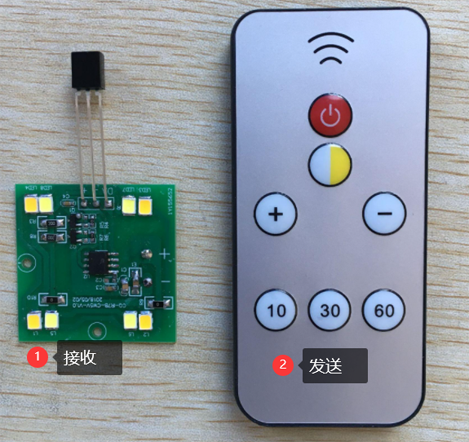
参考原文:
https://blog.csdn.net/wllw7176/article/details/110506677
两个驱动文件
gpio-ir-recv.c /* Copyright (c) 2012, Code Aurora Forum. All rights reserved. * * This program is free software; you can redistribute it and/or modify * it under the terms of the GNU General Public License version 2 and * only version 2 as published by the Free Software Foundation. * * This program is distributed in the hope that it will be useful, * but WITHOUT ANY WARRANTY; without even the implied warranty of * MERCHANTABILITY or FITNESS FOR A PARTICULAR PURPOSE. See the * GNU General Public License for more details. */ #include <linux/kernel.h> #include <linux/init.h> #include <linux/module.h> #include <linux/interrupt.h> #include <linux/gpio.h> #include <linux/slab.h> #include <linux/of.h> #include <linux/of_gpio.h> #include <linux/platform_device.h> #include <linux/irq.h> #include <media/rc-core.h> #include <media/gpio-ir-recv.h> #define GPIO_IR_DRIVER_NAME "gpio-rc-recv" #define GPIO_IR_DEVICE_NAME "gpio_ir_recv" struct gpio_rc_dev { struct rc_dev *rcdev; int gpio_nr; bool active_low; }; #ifdef CONFIG_OF /* * Translate OpenFirmware node properties into platform_data */ static int gpio_ir_recv_get_devtree_pdata(struct device *dev, struct gpio_ir_recv_platform_data *pdata) { struct device_node *np = dev->of_node; enum of_gpio_flags flags; int gpio; gpio = of_get_gpio_flags(np, 0, &flags); if (gpio < 0) { if (gpio != -EPROBE_DEFER) dev_err(dev, "Failed to get gpio flags (%d)\n", gpio); return gpio; } pdata->gpiogpio_nr = gpio; pdata->active_low = (flags & OF_GPIO_ACTIVE_LOW); /* probe() takes care of map_name == NULL or allowed_protos == 0 */ pdata->map_name = of_get_property(np, "linux,rc-map-name", NULL); pdata->allowed_protos = 0; return 0; } static const struct of_device_id gpio_ir_recv_of_match[] = { { .compatible = "gpio-ir-receiver", }, { }, }; MODULE_DEVICE_TABLE(of, gpio_ir_recv_of_match); #else /* !CONFIG_OF */ #define gpio_ir_recv_get_devtree_pdata(dev, pdata) (-ENOSYS) #endif static irqreturn_t gpio_ir_recv_irq(int irq, void *dev_id) { struct gpio_rc_dev *gpio_dev = dev_id; int gval; int rc = 0; enum raw_event_type type = IR_SPACE; gval = gpio_get_value(gpio_dev->gpio_nr); if (gval < 0) goto err_get_value; if (gpio_dev->active_low) gval = !gval; if (gval == 1) type = IR_PULSE; rc = ir_raw_event_store_edge(gpio_dev->rcdev, type); if (rc < 0) goto err_get_value; ir_raw_event_handle(gpio_dev->rcdev); err_get_value: return IRQ_HANDLED; } static int gpio_ir_recv_probe(struct platform_device *pdev) { struct gpio_rc_dev *gpio_dev; struct rc_dev *rcdev; const struct gpio_ir_recv_platform_data *pdata = pdev->dev.platform_data; int rc; if (pdev->dev.of_node) { struct gpio_ir_recv_platform_data *dtpdata = devm_kzalloc(&pdev->dev, sizeof(*dtpdata), GFP_KERNEL); if (!dtpdata) return -ENOMEM; rc = gpio_ir_recv_get_devtree_pdata(&pdev->dev, dtpdata); if (rc) return rc; pdata = dtpdata; } if (!pdata) return -EINVAL; if (pdata->gpio_nr < 0) return -EINVAL; gpio_dev = kzalloc(sizeof(struct gpio_rc_dev), GFP_KERNEL); if (!gpio_dev) return -ENOMEM; rcdev = rc_allocate_device(); if (!rcdev) { rc = -ENOMEM; goto err_allocate_device; } rcdev->priv = gpio_dev; rcdev->driver_type = RC_DRIVER_IR_RAW; rcdev->input_name = GPIO_IR_DEVICE_NAME; rcdev->input_phys = GPIO_IR_DEVICE_NAME "/input0"; rcdev->input_id.bustype = BUS_HOST; rcdev->input_id.vendor = 0x0001; rcdev->input_id.product = 0x0001; rcdev->input_id.version = 0x0100; rcdev->dev.parent = &pdev->dev; rcdev->driver_name = GPIO_IR_DRIVER_NAME; if (pdata->allowed_protos) rcdev->allowed_protocols = pdata->allowed_protos; else rcdev->allowed_protocols = RC_BIT_ALL; rcdev->map_name = pdata->map_name ?: RC_MAP_EMPTY; gpio_dev->rcdevrcdev = rcdev; gpio_dev->gpio_nr = pdata->gpio_nr; gpio_dev->active_low = pdata->active_low; rc = gpio_request(pdata->gpio_nr, "gpio-ir-recv"); if (rc < 0) goto err_gpio_request; rc = gpio_direction_input(pdata->gpio_nr); if (rc < 0) goto err_gpio_direction_input; rc = rc_register_device(rcdev); if (rc < 0) { dev_err(&pdev->dev, "failed to register rc device\n"); goto err_register_rc_device; } platform_set_drvdata(pdev, gpio_dev); rc = request_any_context_irq(gpio_to_irq(pdata->gpio_nr), gpio_ir_recv_irq, IRQF_TRIGGER_FALLING | IRQF_TRIGGER_RISING, "gpio-ir-recv-irq", gpio_dev); if (rc < 0) goto err_request_irq; return 0; err_request_irq: rc_unregister_device(rcdev); rcdev = NULL; err_register_rc_device: err_gpio_direction_input: gpio_free(pdata->gpio_nr); err_gpio_request: rc_free_device(rcdev); err_allocate_device: kfree(gpio_dev); return rc; } static int gpio_ir_recv_remove(struct platform_device *pdev) { struct gpio_rc_dev *gpio_dev = platform_get_drvdata(pdev); free_irq(gpio_to_irq(gpio_dev->gpio_nr), gpio_dev); rc_unregister_device(gpio_dev->rcdev); gpio_free(gpio_dev->gpio_nr); kfree(gpio_dev); return 0; } #ifdef CONFIG_PM static int gpio_ir_recv_suspend(struct device *dev) { struct platform_device *pdev = to_platform_device(dev); struct gpio_rc_dev *gpio_dev = platform_get_drvdata(pdev); if (device_may_wakeup(dev)) enable_irq_wake(gpio_to_irq(gpio_dev->gpio_nr)); else disable_irq(gpio_to_irq(gpio_dev->gpio_nr)); return 0; } static int gpio_ir_recv_resume(struct device *dev) { struct platform_device *pdev = to_platform_device(dev); struct gpio_rc_dev *gpio_dev = platform_get_drvdata(pdev); if (device_may_wakeup(dev)) disable_irq_wake(gpio_to_irq(gpio_dev->gpio_nr)); else enable_irq(gpio_to_irq(gpio_dev->gpio_nr)); return 0; } static const struct dev_pm_ops gpio_ir_recv_pm_ops = { .suspend = gpio_ir_recv_suspend, .resume = gpio_ir_recv_resume, }; #endif static struct platform_driver gpio_ir_recv_driver = { .probe = gpio_ir_recv_probe, .remove = gpio_ir_recv_remove, .driver = { .name = GPIO_IR_DRIVER_NAME, .of_match_table = of_match_ptr(gpio_ir_recv_of_match), #ifdef CONFIG_PM .pm = &gpio_ir_recv_pm_ops, #endif }, }; module_platform_driver(gpio_ir_recv_driver); MODULE_DESCRIPTION("GPIO IR Receiver driver"); MODULE_LICENSE("GPL v2");
ir-nec-decoder.c
/* ir-nec-decoder.c - handle NEC IR Pulse/Space protocol * * Copyright (C) 2010 by Mauro Carvalho Chehab * * This program is free software; you can redistribute it and/or modify * it under the terms of the GNU General Public License as published by * the Free Software Foundation version 2 of the License. * * This program is distributed in the hope that it will be useful, * but WITHOUT ANY WARRANTY; without even the implied warranty of * MERCHANTABILITY or FITNESS FOR A PARTICULAR PURPOSE. See the * GNU General Public License for more details. */ #include <linux/bitrev.h> #include <linux/module.h> #include "rc-core-priv.h" #define NEC_NBITS 32 #define NEC_UNIT 562500 /* ns */ #define NEC_HEADER_PULSE (16 * NEC_UNIT) #define NECX_HEADER_PULSE (8 * NEC_UNIT) /* Less common NEC variant */ #define NEC_HEADER_SPACE (8 * NEC_UNIT) #define NEC_REPEAT_SPACE (4 * NEC_UNIT) #define NEC_BIT_PULSE (1 * NEC_UNIT) #define NEC_BIT_0_SPACE (1 * NEC_UNIT) #define NEC_BIT_1_SPACE (3 * NEC_UNIT) #define NEC_TRAILER_PULSE (1 * NEC_UNIT) #define NEC_TRAILER_SPACE (10 * NEC_UNIT) /* even longer in reality */ #define NECX_REPEAT_BITS 1 enum nec_state { STATE_INACTIVE, STATE_HEADER_SPACE, STATE_BIT_PULSE, STATE_BIT_SPACE, STATE_TRAILER_PULSE, STATE_TRAILER_SPACE, }; /** * ir_nec_decode() - Decode one NEC pulse or space * @dev: the struct rc_dev descriptor of the device * @duration: the struct ir_raw_event descriptor of the pulse/space * * This function returns -EINVAL if the pulse violates the state machine */ static int ir_nec_decode(struct rc_dev *dev, struct ir_raw_event ev) { struct nec_dec *data = &dev->raw->nec; u32 scancode; u8 address, not_address, command, not_command; bool send_32bits = false; if (!(dev->enabled_protocols & RC_BIT_NEC)) return 0; if (!is_timing_event(ev)) { if (ev.reset) data->state = STATE_INACTIVE; return 0; } IR_dprintk(2, "NEC decode started at state %d (%uus %s)\n", data->state, TO_US(ev.duration), TO_STR(ev.pulse)); switch (data->state) { case STATE_INACTIVE: if (!ev.pulse) break; if (eq_margin(ev.duration, NEC_HEADER_PULSE, NEC_UNIT * 2)) { data->is_nec_x = false; data->necx_repeat = false; } else if (eq_margin(ev.duration, NECX_HEADER_PULSE, NEC_UNIT / 2)) data->is_nec_x = true; else break; data->count = 0; data->state = STATE_HEADER_SPACE; return 0; case STATE_HEADER_SPACE: if (ev.pulse) break; if (eq_margin(ev.duration, NEC_HEADER_SPACE, NEC_UNIT)) { data->state = STATE_BIT_PULSE; return 0; } else if (eq_margin(ev.duration, NEC_REPEAT_SPACE, NEC_UNIT / 2)) { if (!dev->keypressed) { IR_dprintk(1, "Discarding last key repeat: event after key up\n"); } else { rc_repeat(dev); IR_dprintk(1, "Repeat last key\n"); data->state = STATE_TRAILER_PULSE; } return 0; } break; case STATE_BIT_PULSE: if (!ev.pulse) break; if (!eq_margin(ev.duration, NEC_BIT_PULSE, NEC_UNIT / 2)) break; data->state = STATE_BIT_SPACE; return 0; case STATE_BIT_SPACE: if (ev.pulse) break; if (data->necx_repeat && data->count == NECX_REPEAT_BITS && geq_margin(ev.duration, NEC_TRAILER_SPACE, NEC_UNIT / 2)) { IR_dprintk(1, "Repeat last key\n"); rc_repeat(dev); data->state = STATE_INACTIVE; return 0; } else if (data->count > NECX_REPEAT_BITS) data->necx_repeat = false; data->bits <<= 1; if (eq_margin(ev.duration, NEC_BIT_1_SPACE, NEC_UNIT / 2) data->bits |= 1; else if (!eq_margin(ev.duration, NEC_BIT_0_SPACE, NEC_UNIT / 2)) break; data->count++; if (data->count == NEC_NBITS) data->state = STATE_TRAILER_PULSE; else data->state = STATE_BIT_PULSE; return 0; case STATE_TRAILER_PULSE: if (!ev.pulse) break; if (!eq_margin(ev.duration, NEC_TRAILER_PULSE, NEC_UNIT / 2)) break; data->state = STATE_TRAILER_SPACE; return 0; case STATE_TRAILER_SPACE: if (ev.pulse) break; if (!geq_margin(ev.duration, NEC_TRAILER_SPACE, NEC_UNIT / 2)) break; address = bitrev8((data->bits >> 24) & 0xff); not_address = bitrev8((data->bits >> 16) & 0xff); command = bitrev8((data->bits >> 8) & 0xff); not_command = bitrev8((data->bits >> 0) & 0xff); if ((command ^ not_command) != 0xff) { IR_dprintk(1, "NEC checksum error: received 0x%08x\n", data->bits); send_32bits = true; } if (send_32bits) { /* NEC transport, but modified protocol, used by at * least Apple and TiVo remotes */ scancode = data->bits; IR_dprintk(1, "NEC (modified) scancode 0x%08x\n", scancode); } else if ((address ^ not_address) != 0xff) { /* Extended NEC */ scancode = address << 16 | not_address << 8 | command; IR_dprintk(1, "NEC (Ext) scancode 0x%06x\n", scancode); } else { /* Normal NEC */ scancode = address << 8 | command; IR_dprintk(1, "NEC scancode 0x%04x\n", scancode); } if (data->is_nec_x) data->necx_repeat = true; rc_keydown(dev, RC_TYPE_NEC, scancode, 0); data->state = STATE_INACTIVE; return 0; } IR_dprintk(1, "NEC decode failed at count %d state %d (%uus %s)\n", data->count, data->state, TO_US(ev.duration), TO_STR(ev.pulse)); data->state = STATE_INACTIVE; return -EINVAL; } static struct ir_raw_handler nec_handler = { .protocols = RC_BIT_NEC, .decode = ir_nec_decode, }; static int __init ir_nec_decode_init(void) { ir_raw_handler_register(&nec_handler); printk(KERN_INFO "IR NEC protocol handler initialized\n"); return 0; } static void __exit ir_nec_decode_exit(void) { ir_raw_handler_unregister(&nec_handler); } module_init(ir_nec_decode_init); module_exit(ir_nec_decode_exit); MODULE_LICENSE("GPL"); MODULE_AUTHOR("Mauro Carvalho Chehab"); MODULE_AUTHOR("Red Hat Inc. (http://www.redhat.com)"); MODULE_DESCRIPTION("NEC IR protocol decoder");参考文章中的dts文件:
gpio-ir-receiver { compatible = "gpio-ir-receiver"; gpios = <&gpio4 19 GPIO_ACTIVE_HIGH>; //连接红外的中断引脚 active_low = <1>; //红外接收器是否将信号取反,有些红外接收器会将接收到的高低电平信号反向输出,比如我使用的hx1838红外接收器 linux,rc-map-name = "rc-hx18380-carmp3"; //红外scancode与实际input_evnent code映射表名称,要在rc_register_device注册,具体见gpio-ir-recv.c allowed_protos = <0x100>; /*NEC protocol*/ //保留,驱动中并未使用 };另一个文件里面调用的
ir-nec-decoder.c

这个函数是Linux内核中的红外处理申请函数
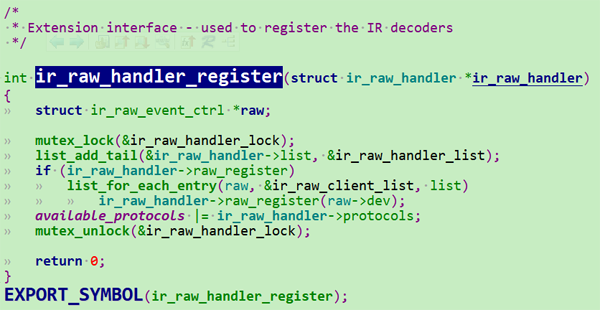
这里主要是注册一个解码的结构体
ir-nec-decoder.c

gpio-ir-recv.c

ir_raw_event_store_edge() 这个函数用来计算电平的持续时间。
ir_raw_event_handle() 用来处理这个电平表示什么含义。

驱动程序里面,首先是判断当前GPIO电平,如果是低电平,就进入红外解析,如果不是,或者获取失败,就退出程序。
4.红外数据处理程序解析
内核专门开了一个线程来处理数据解析
rc-ir-raw.c


处理函数其实就是处理电平时间长短来决定数字信号
ir-nec-decoder.c

这里是判断头,这个时间和9ms进行比较
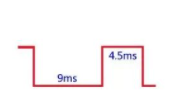
9ms 从哪里来的,可以看看这里
ir-nec-decoder.c


拿到头后,这个switch函数就继续往下跑
ir-nec-decoder.c
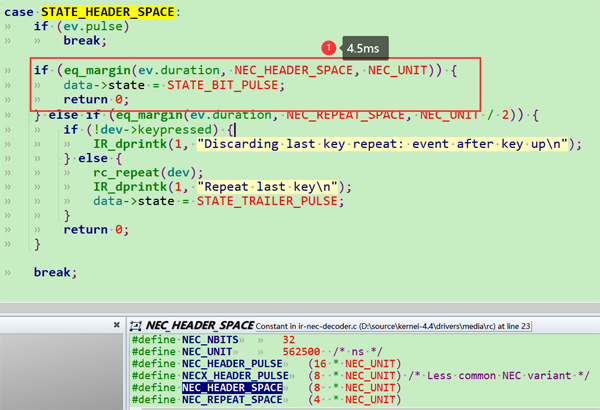
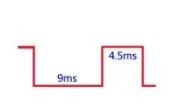
然后就是判断 1 和 0 的时候了

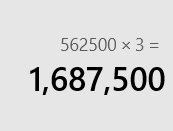
ir-nec-decoder.c

上面那个就是1,下面那个就是0。
ir-nec-decoder.c

这里是在另一个模块中注册的映射
不同的红外键值对应不同的上报按键键值
rc-trekstor.c
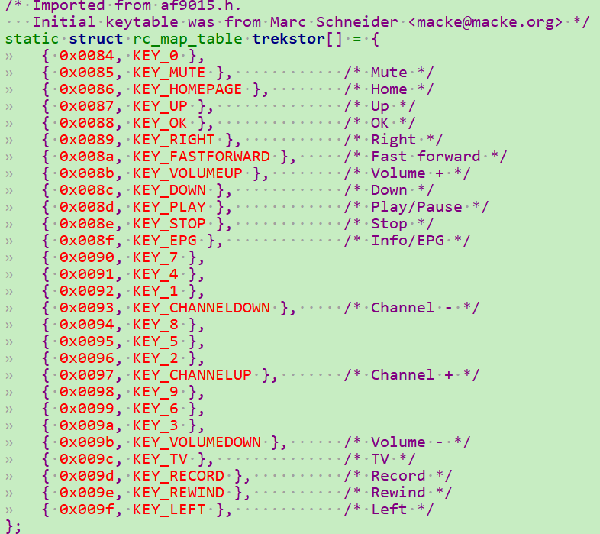
感谢各位的阅读,以上就是“Linux红外驱动是什么”的内容了,经过本文的学习后,相信大家对Linux红外驱动是什么这一问题有了更深刻的体会,具体使用情况还需要大家实践验证。这里是亿速云,小编将为大家推送更多相关知识点的文章,欢迎关注!
免责声明:本站发布的内容(图片、视频和文字)以原创、转载和分享为主,文章观点不代表本网站立场,如果涉及侵权请联系站长邮箱:is@yisu.com进行举报,并提供相关证据,一经查实,将立刻删除涉嫌侵权内容。